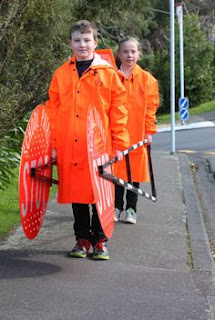Patrol members need to arrive at school with enough time to put on their uniforms, take the STOP signs from the storage area and make their way to the patrol location by the time the patrol is due to start
I. Carrying the signs
STOP signs are safest when carried 'stretcher fashion', preferably with the discs at the front. Take extra car on windy days, when it might be a good idea to have the discs horizontal, facing the ground,to reduce wind resistance.
If you're operating a kea crossing, the supervisor carries the two kea flags and must put them in place before the patrol starts
The patrol leader and supervisor should ensure that pedestrians are not allowed to cross the road while the patrol is being set up.
II. Setting up the patrol
When the patrol reaches the crossing:
1. The patrol member who's going to cross the road stands behind the person who won't be crossing.
What's a barrier arm?
A barrier arm is an arm raised sideways at right angles to the body to prevent children on the footpath trying to cross the road.
3. The leader checks the approaching traffic. When they can see that there's no approaching traffic between the crossing and an established 'mark' or reference point, they call 'Sign Out'. Both patrol members swing their signs into the roadway so the signs are parallel to each other.
4. The leader calls 'Check'. Both patrol members check that any approaching traffic is going to stop. On multi-lane highways, this includes checking that no-on, including cyclists, is trying to overtake a stationary vehicle. If in doubt, the patrol members wait until all vehicles have stopped.
5. The second patrol member calls 'Clear'- when both patrol members are sure that traffic will stop.
6. The leader calls 'On patrol' and holds out one arm as a barrier, called the barrier are, to stop any student crossing.
7. The other patrol member walks across the road, holding their sign, disc first, at right angles to the traffic so ti can be seen easily.
8. When the other patrol member reaches the footpath, or kerb extension, on the other side, they swing their sign so it's parallel to the road, out of the way of traffic. The leader calls 'Signs in' and swings their sign in. The other patrol member attaches their sign to the post.
III. Operating the patrol
Once the patrol has been set up, it needs to operate quickly, smoothly and efficiently to minimize traffic disruption and delays. It's important to make sure that children waiting to cross stand well back from the STOP sign or behind the pedestrian limit line, so that patrol members have a clear view of the road.
Patrols operate in five steps:
1. The patrol members check approaching traffic. When there's a suitable gap, the leader call 'Signs out'. In unison, the patrol members raise their barrier arms and swing their STOP signs into the roadway.
2. The leader calls 'Check'. Both patrol members look to make sure any approaching vehicles are going to stop.
3. The second patrol member confirms that traffic is slowing or has stopped by calling 'Clear'. The leader call 'Crossing' and both patrol members lower their barrier arms.
4. As the last pedestrian enters the crossing, the patrol member raises their barrier arm to prevent latecomers trying to cross.
5. When the last pedestrian reaches the footpath or kerb extension, the leader calls 'Signs in' and both patrol members lower their barrier arms an swing in their signs.
VI. Ending the patrol
Patrols follow six steps before going off duty:
1. When it's time to finish the school patrol, and as long as there are no pedestrians waiting to cross, the leader or adult supervisor lets the team know they're going off petrol.
2. The patrol member who's going to cross the road unhooks their STOP sign and rests the hook at the foot of the post. When there's a suitable break in the traffic, the leader calls 'Signs out' and both patrol members swing their signs into the road and raise their barrier arms.
3. The leaders call 'Check' and both patrol members check that any approaching vehicles are about to stop
4. The second member calls 'Clear'- when both patrol members are sure that traffic will stop.
5. When it's all clear, the leader calls 'Off patrol'. The returning patrol member crosses the road, holding their STOP sign at right angles to the traffic.
6. When they'er safely clear of the crossing, the remaining patrol member removes their sign and both signs are carried stretcher fashion to the equipment storage area. Note they should be carried parallel to the roadway, with particular care around other people and vehicles.
If you're operating a kea crossing, the supervisor removers both flags after the patrol members have come off the crossing.




















0 comments:
Post a Comment